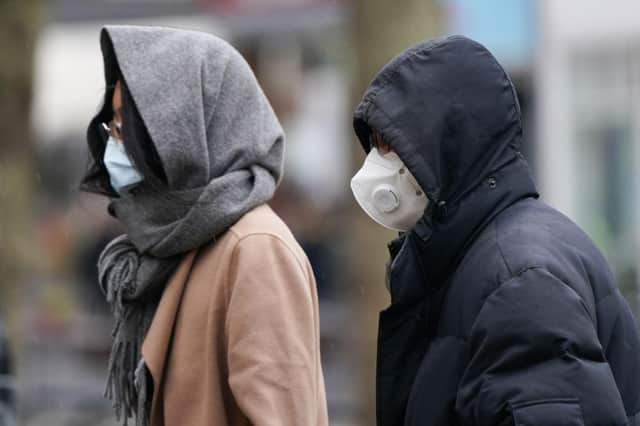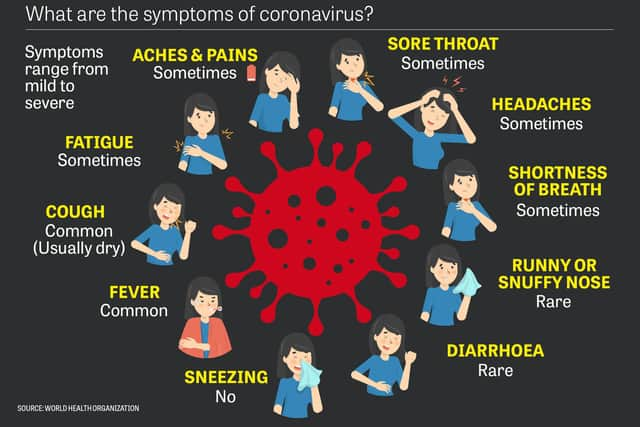What does the term social Distancing mean? Everything you need to know as UK government implements tighter measures to tackle outbreak


As part of the “delay phase”, “social distancing” measures are being introduced, with the public already seeing so many large scale events and gatherings being cancelled in a bid to slow the spread of the virus.
Nicola Sturgeon, Scotland’s First Minister, has already advised against gatherings of more than 500 people, and the Republic of Ireland has announced a Lockdown.
Advertisement
Hide AdAdvertisement
Hide AdThis is what you need to know about social distancing, and how it has worked in the past.


What does social distancing mean?
As the government switches tactics to delay the spread of coronavirus rather than simply contain it, social distancing is a key part of the plan.
The delay phase is designed to slow the spread of the virus.
The government believes it would be beneficial to delay the peak phase of the virus to the summer months when there is less pressure on the NHS.
Advertisement
Hide AdAdvertisement
Hide AdSome businesses may be asked to consider having their employees work from home where possible, and to discourage any unnecessary travel, in order to limit close, prolonged contact with those infected.
If social distancing measures do come into place, public gatherings could also be cancelled, schools may be closed and the public may be advised to avoid restaurants and public transport.
Have other places introduced social distancing?
Other countries affected by the spread of the virus have introduced social distancing measures.
In Europe’s toughest lockdown, the Italian Prime Minister Giuseppe Conte said that all shops apart from food stores and pharmacies are to close, including bars, restaurants, hairdressers, schools, gyms and more.
Advertisement
Hide AdAdvertisement
Hide AdIn China, where the virus originated, there are strict lockdown proceedings with the World Health Organisation saying that China’s containment measures might have saved thousands from being infected.
Aggressive social distancing in China saw cities sealed off, businesses and schools shut down and people being ordered to stay indoors.
Does social distancing help stop the spread of viruses?
The Centres for Disease Control and Prevention (CDC) states that while there is currently no vaccine or drug available to treat COVID-19, “community-based interventions such as school dismissals, event cancellations, social distancing, and creating employee plans to work remotely can help slow the spread of COVID-19.”
In the past, countries affected by outbreaks of viruses have introduced social distancing measures which have proved successful.
Advertisement
Hide AdAdvertisement
Hide AdFor example, during the 2009 Swine Flu pandemic, which originated in Mexico, the Mexican government closed most of Mexico City's public and private facilities in an attempt to contain the spread of the virus.
A study from the National Institutes of Health (NIH) states that the “mandatory school closures and other social distancing measures reduced influenza transmission rates in Mexico”.
Another report from NIH states: “The social distancing measures implemented by the Mexican health authorities in spring 2009 were effective in reducing disease transmission by more than one-third.”
The outcome of how two cities 900 miles apart handled an outbreak tells a similar story about the effectiveness of social distancing.
Advertisement
Hide AdAdvertisement
Hide AdIn 1918 during the Spanish flu pandemic, the city of Philadelphia ignored the warnings of influenza among soldiers preparing for World War 1 and went ahead with a march to support the war effort.
The march drew in 200,000 people to watch the procession. Three days later, all 31 of Philadelphia’s hospitals were filled with patients infected by the Spanish flu.
At the end of that week, more than 4,500 were dead from the outbreak. The city would eventually close down, although at that point it was too late.
However, in St. Louis, it was a very different story. The city shut down schools, playgrounds, churches and more, with work shifts spread out and public transport restricted. Public gatherings of more than 20 people were banned.
Advertisement
Hide AdAdvertisement
Hide AdSt. Louis actually had one of the lowest rates of infection of any US city, with only 1,703 deaths over the course of the outbreak. Overall, Philadelphia suffered from 16,000 fatalities.
A study for the Proceedings of the National Academy of Sciences of the United States of America said: “We found that aggressive early intervention was significantly associated with a lower peak of excess mortality.”
The government will announce the outcome of its emergency Cobra meeting later today (12 March).
Coronavirus Facts:
What is coronavirus?
COVID-19 is a respiratory illness that can affect lungs and airways. It is caused by a virus called coronavirus.
What caused coronavirus?
Advertisement
Hide AdAdvertisement
Hide AdThe outbreak started in Wuhan in China in December 2019 and it is thought that the virus, like others of its kind, has come from animals.
How is it spread?
As this is such a new illness, experts still aren’t sure how it is spread. But.similar viruses are spread in cough droplets. Therefore covering your nose and mouth when sneezing and coughing, and disposing of used tissues straight away is advised. Viruses like coronavirus cannot live outside the body for very long.
What are the symptoms?
The NHS states that the symptoms are: a dry cough, high temperature and shortness of breath - but these symptoms do not necessarily mean you have the illness. Look out for flu-like symptoms, such as aches and pains, nasal congestion, runny nose and a sore throat. It’s important to remember that some people may become infected but won’t develop any symptoms or feel unwell.
What precautions can be taken?
Washing your hands with soap and water thoroughly. The NHS also advises to cover your mouth and nose with a tissue or your sleeve (not your hands) when you cough or sneeze; put used tissues in the bin immediately and try to avoid close contact with people who are unwell. Also avoiding touching eyes, nose and mouth unless your hands are clean.
Should I avoid public places?
Advertisement
Hide AdAdvertisement
Hide AdMost people who feel well can continue to go to work, school and public places and should only stay at home and self isolate if advised by a medical professional or the coronavirus service.
What should I do if I feel unwell?
Don’t go to your GP but instead call NHS 111 or look online at the coronavirus service that can tell you if you need medical help and what to do next.
When to call NHS 111
NHS 111 should be used if you feel unwell with coronavirus symptoms, have been in a country with a high risk of coronavirus in the last 14 days or if you have been in close contact with someone with the virus.